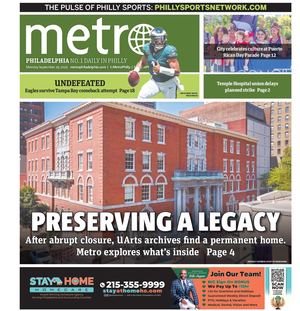When a massive fire at the abandoned Buck Hosiery Factory at York and Jasper streets killed two firefighters in April, many said the adjacent Front Street warehouse – which houses retail on the bottom floor while the top four levels sit vacant – would be the next to go.
So, too, when a fire broke out at a vacant property on Front just below Girard Avenue last month, temporarily suspending service to the Market-Frankford Line. One resident said of the warehouse, dubbed the “white elephant” by neighbors, “That’s the building that’s going to take out the El.”
But according to Jesse Munoz, a Philadelphia-born entrepreneur who formerly developed Buena Vista Plaza in Fairhill and currently owns Cafe Venice on Delaware Avenue, neighbors can rest easy. After nine years of negotiations, he purchased the building from alleged slumlord Daniel Waisbord in a sale that became final yesterday. “It’s a great thing because there’s not going to be a fire,” Munoz said. “It’s not boarded up. It’s not abandoned. It’s going to create jobs.”
Munoz understands how the hulking shell got its nickname. “An elephant in the room is the biggest problem in the room,” he said during a visit to the site last month. “This building is the biggest problem in the community.” He also sees the latent value Waisbord never realized. “He is not from the community,” Munoz said. “He doesn’t understand the potential of this community. Hopefully, this will be a renewal of its potential.”
He hopes the redevelopment will drive the neighborhood forward. “I think the power of the space is going to have such a huge impact,” he said. “People are going to take inspiration from the space and say, ‘Wow, I’m going to take care of my home.'”
Now comes the million dollar-plus question. What exactly does Munoz plan to do with the elephant? “The first thing will be to clean up this mess,” he said last month, eyeing the dilapidated facade and trash-strewn sidewalks. “Developing this building will generate a sense of community ownership. All these things will allow the neighborhood to prosper. I want to turn it into a landmark.”
His eyes lit up and he began to sketch out his vision, tracing shapes in the air with his finger. Landscaping over here. Lights over there. Awnings. A cafe – or maybe a laundromat. “It’s definitely a site for commercial development,” he said at a second meeting yesterday. “I’m looking at doing office space, if possible, with the potential of individual apartments.”
He is mulling over a combination of ground-floor retail, live-work artist lofts and student rental units due to the building’s proximity to the El – it literally butts up against the tracks at the York-Dauphin station.
“We’re talking probably about a year, a year and a half from takeover to finished project,” he said. “For the cleanup, I’ll have a presence here every day fixing things because right now, it’s a mess. But the feasibility is here. The parking is here. It’s a heavily residential area. It’s close to transportation.”
He said the exact timeframe will be determined by funding. Ideally, renovation will be funded by a $1 to $2 million lump sum loan, grant, investment or some combination thereof. But if the money is slow to roll in, the timeline may stretch as restoration could occur in phases, with each improvement increasing the building’s value and leveraging more funding. “One week, you buy a brick. The next, a can of paint,” Munoz said. “Eventually, you’ll build it. But the goal, for me, is one lump sum and done.”
He said the businesses now renting space on the building’s bottom floor – taqueria Mi Guarapo Deli Market and Helene’s Check Cashing – will remain, while currently-neglected space for a third retail tenant will be cleaned up and shopped around. Work on the facade is already underway – one wall where the bricks were coming loose is now spackled over with fresh cement and much of the sidewalk trash has been swept up.
“It’s going to be exciting. It’s really going to make a big difference,” Munoz said. “I can see that it’s going to be a ‘wow.’ It’s funny how you walk past the street corner [where the property is currently occupied by storefronts] and it’s like, ‘Ooh, that’s nice.’ Can you imagine? The whole block’s going to look like that.”
As the project is still in its planning stages, Munoz is taking suggestions. “I’m coming in with an open heart,” he cracked a wide grin. “I can’t wait – it’s going to be a beautiful site.”
By the numbers
The building is 32,930 square feet.
Waisbord sat on the property for 15 years and did virtually nothing to develop it.
$500,000 was the ballpark purchase price.
Munoz estimates it will cost $100,000 to restore the building’s facade, giving it curb appeal.
$1 to $2 million
























